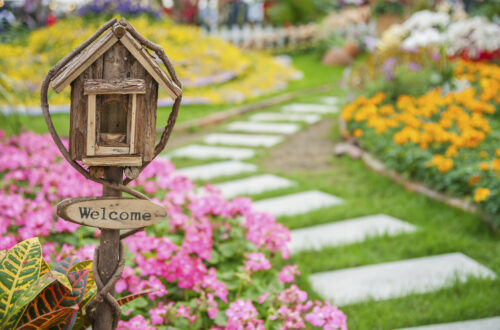There is nothing nicer on a hot sunny day than to sit under a shady tree on a nice lush green lawn and to sip an icy cold drink. The truth is that grass seldom does well under trees, and even those that have been specially cultivated and hybridized will require the right amount of light. Photosynthesis is reduced by shade, and grass has less energy to use for healthy growth. Left without any light, even shade tolerant turf becomes more susceptible to daily wear and tear as well as extreme heat, cold, pests and overly dry conditions.
Shade Grass Needn’t Be Starved of Nourishment
Nearly all types of grass need a good balance of water, air, warmth and nutrition. Most types of grass have to have a certain amount of sunlight, and grasses which grow under trees in shady conditions battle with the right amount of nutrients as well as enough moisture. They find it difficult to compete with tree roots that are also competing for nutrients and water in the soil. The soil is not able to supply both the tree roots and the grass with life giving moisture, and eventually the grass simply dies off. Not only that, falling leaves can actually alter the soil properties and the grass may not like the type of soil it finds itself in.
The average garden gets a mixture of full sun and shade during the day. Some people with shady gardens may try to prune back their trees to allow sunlight through, but with enormous trees you don’t want to spoil their shape. There are other less drastic things you can do to get an attractive lawn, and the first thing is to look at the best grass types for shady areas and then to prepare the ground. The ground should be well dug over and the soil structure should be right.
If you are planting shade tolerant turf seeds, different seeds will establish themselves at different speeds. Of course you can also opt to choose quality turf which has been raised from seed already. The secret to getting a lawn to grow in the shade is to improving the soil in order to get the more shade tolerant grass to be strong. Strong roots will ensure the grass can stand its own in shade.
How Does Your Garden Grow?
Growing grass in shade is possible. Choosing the right shade tolerant grasses is the first step to successfully growing grass in shade. Fine fescue grass is the most tolerant of cool season grasses, and the grass is adapted to make the most of what light it receives. It can also get by without high levels of nutrition. The UK is known for its beautiful country gardens and they have formulated shade tolerant turf for various purposes in the garden. Their high shade and drought tolerant grasses also offer better wear tolerance because of their high shoot density. Shade tolerant turf or shade grass spreads with a system of stolons, will tolerate extreme weather temperatures better and will not easily brown with climate change. Beautiful lawns that spread evenly under trees in the shade don’t come about without some effort, and with a generous supply of nutrients and moisture and the right choice of grass, you will be able to spend many hours relaxing on a lovely lawn in the shade.
There is nothing nicer on a hot sunny day than to sit under a shady tree on a nice lush green lawn and to sip an icy cold drink. The truth is that grass seldom does well under trees, and even those that have been specially cultivated and hybridized will require the right amount of light. Photosynthesis is reduced by shade, and grass has less energy to use for healthy growth. Left without any light, even shade tolerant turf becomes more susceptible to daily wear and tear as well as extreme heat, cold, pests and overly dry conditions.
Shade Grass Needn’t Be Starved of Nourishment
Nearly all types of grass need a good balance of water, air, warmth and nutrition. Most types of grass have to have a certain amount of sunlight, and grasses which grow under trees in shady conditions battle with the right amount of nutrients as well as enough moisture. They find it difficult to compete with tree roots that are also competing for nutrients and water in the soil. The soil is not able to supply both the tree roots and the grass with life giving moisture, and eventually the grass simply dies off. Not only that, falling leaves can actually alter the soil properties and the grass may not like the type of soil it finds itself in.
Prepare Your Ground Well and Select Shade Tolerant Turf
The average garden gets a mixture of full sun and shade during the day. Some people with shady gardens may try to prune back their trees to allow sunlight through, but with enormous trees you don’t want to spoil their shape. There are other less drastic things you can do to get an attractive lawn, and the first thing is to look at the best grass types for shady areas and then to prepare the ground. The ground should be well dug over and the soil structure should be right.
If you are planting shade tolerant turf seeds, different seeds will establish themselves at different speeds. Of course you can also opt to choose quality turf which has been raised from seed already. The secret to getting a lawn to grow in the shade is to improving the soil in order to get the more shade tolerant grass to be strong. Strong roots will ensure the grass can stand its own in shade.
How Does Your Garden Grow?
Growing grass in shade is possible. Choosing the right shade tolerant grasses is the first step to successfully growing grass in shade. Fine fescue grass is the most tolerant of cool season grasses, and the grass is adapted to make the most of what light it receives. It can also get by without high levels of nutrition. The UK is known for its beautiful country gardens and they have formulated shade tolerant turf for various purposes in the garden. Their high shade and drought tolerant grasses also offer better wear tolerance because of their high shoot density. Shade tolerant turf or shade grass spreads with a system of stolons, will tolerate extreme weather temperatures better and will not easily brown with climate change. Beautiful lawns that spread evenly under trees in the shade don’t come about without some effort, and with a generous supply of nutrients and moisture and the right choice of grass, you will be able to spend many hours relaxing on a lovely lawn in the shade.

